Polyphagous & Kuroshio Shot Hole Borers & Fusarium Dieback
Polyphagous Shot Hole Borer
The polyphagous Shot Hole Borer (PSHB), Euwallacea sp., and Fusarium euwallaceae, a fungus it carries, has been discovered infesting many species of trees in Southern California. PSHB has been found to vector a symbiotic fungus, Fusarium euwallaceae, which has been identified as a species associated with tree dieback symptoms. Both the beetle and fungus are currently rated “Q” by the California Department of Food and Agriculture (CDFA). Together these pests have been found to infest a wide range of hosts, and they present a major threat to the avocado industry in California.
The fungus associated with the beetle causes defoliation and dieback of branches. This damage is due to destruction of the nutrient and water conducting systems of the tree. Injury occurs when the beetle bores into a tree to create tunnels (galleries) for its eggs and larvae and, in the process, inoculates the tunnels with its symbiotic fungi that subsequently clog the surrounding water conducting tissue, or xylem. Exit holes (0.4-1.57 in width) of the beetle along the tree trunk and branches can be identified due to darkened, stained bark, gumming, or white powdery exudates around the holes.
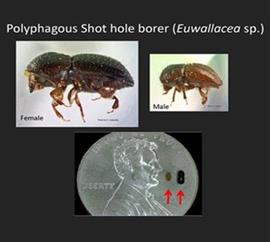
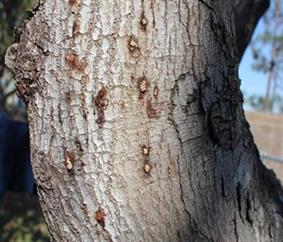
· UC Riverside Eskalen Lab
· USDA Pest Alert
· UC PSHB Information
· California Firewood Task Force
Ornamental and native foliage can fall victim to disease and insect infestation. The increase of these infected plants adds to the overall fire danger risk in Orange County, CA. Infected/infested plants should be removed after they have died.
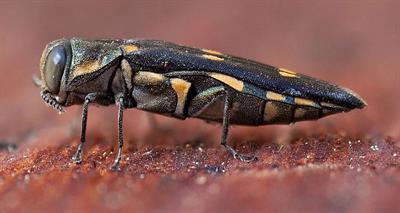
Goldspotted Oak Borer: An infestation of the Goldspotted Oak Borer (GSOB – Agrilus Auroguttatus) has been discovered in approximately 30 oak trees in Orange County as of December 2014. The GSOB is a non-native invasive beetle that has killed an estimated 80,000 oak trees in San Diego County. Scientists believe that the insect was transported to San Diego County via oak firewood from its native range in southeastern Arizona. The Irvine Ranch Conservancy, OC Parks, the Nature Reserve of Orange County, USDA Forest Service, UC Riverside, UC Cooperative Extension and Orange County Fire Authority are currently working in partnership to identify infected oak trees and develop a pest management plan for the GSOB in Orange County.
You can help in our efforts by not moving firewood out of local areas as this is the primary mechanism for widespread infestation. Please do your part and keep firewood local.
For more information:
What is the Goldspotted Oak Borer? (University of California, Agriculture and Natural Resources) |
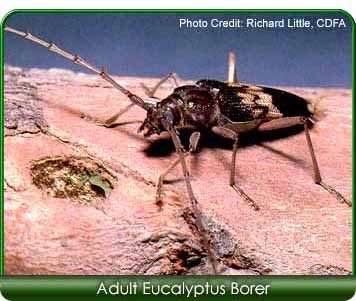
Eucalyptus Trees: Remove all fallen leaves, limbs, litter, debris and loose bark from the ground. Dead trees should be removed (depending upon location). Note: the Eucalyptus longhorn borer, Phoracantha Semipunctata, has been infesting eucalyptus trees in this area. Many of these trees are dead or dying. |
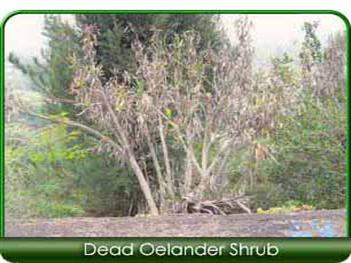
Oleander shrubs, Nerium oleander, have been dying at a rapid rate all over Orange County due to a disease caused by the bacterium Xylella fastidiosa. This has caused widespread destruction of Oleander. Symptoms appear initially as leaf tip dieback that becomes progressively worse throughout the summer, eventually infesting entire branches. As the disease spreads, more of the plant dies. The entire plant will die within about one year of the initial infection. Presently, there are no effective controls, but one means of limiting the spread is to disinfect pruning tools before use on healthy plants. Research shows that plants most susceptible to the disease are those under heat or water stress. |
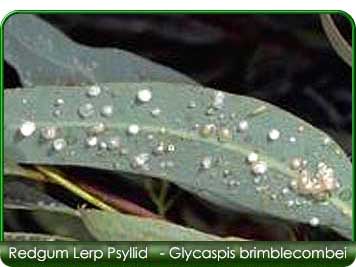
The Red Gum Lerp Psyllid was found in Red Gum Eucalyptus trees in Los Angeles in 1998 and has spread throughout much of California. Psyllids are plant-juice sucking insects that form a cover called a "lerp" which is a small white, hemispherical cap. The psyllid tends to attack trees already under stress due to drought. While the lerp psyllid is not lethal to the tree, its presence can contribute to the tree's death. |